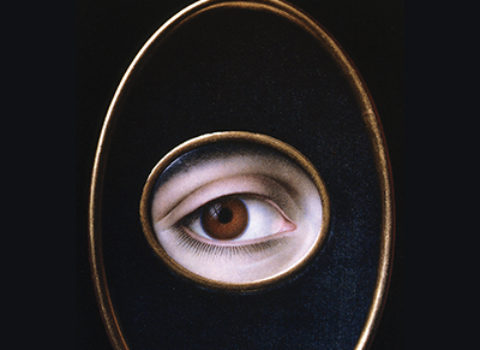On a Friday afternoon in the fall of 2017, a few months after the liberation of Mosul from the Islamic State, a group of neighbors gathered at Mar Mattai, a monastery founded in the fourth century. They unloaded baskets of food, and arranged themselves around a long table in a courtyard. A woman named Niser spread out a tablecloth and put down a plate of dolmas. “It’s a way of celebrating that we still exist,” she told me. More people were arriving—children, grandparents, cousins, aunts, and distant relations—members of one of the oldest Christian communities in the world who had not seen one another for three years.
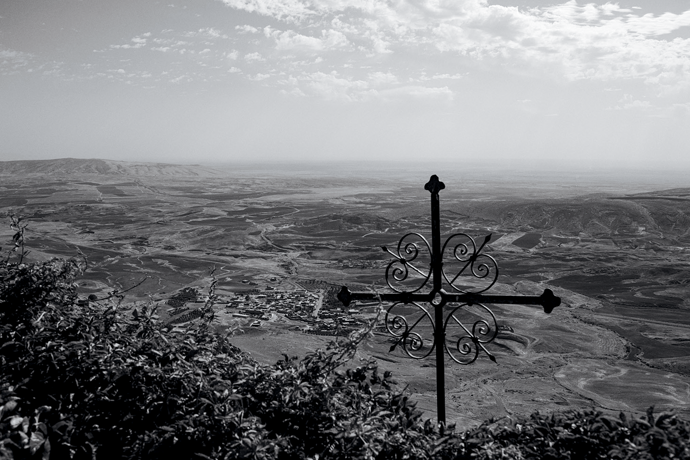
Overlooking the village of Mergey from the old section of the Mar Mattai Monastery, Mount Maqlub, Iraq. All photographs from Iraq (October 2017) and Jerusalem (March 2018) by Nicole Tung
In the summer of 2014, the Islamic State occupied Christian cities and villages across northern Iraq, appropriated Christian homes, and destroyed farms of Christian families. When Islamic State commanders separated men from women and imposed jizyah, or extortion taxes, their purpose was extreme: they meant to subjugate the Christians or drive them away from the land. Mar Mattai is some twenty miles from Mosul, Iraq’s second-largest city, where more than one hundred thousand Christians were displaced from their homes. One of the children led me to a wall at the edge of the monastery and pointed below to the brown, dusty tracts of fields that lie at the edge of a region once known as Mesopotamia, the land between two rivers. From above, I saw how exposed the road to Mosul was.
The Christians here have endured invasions by Persians, Kurds, and Turks, but they have recovered after each persecution. This is, in part, their tradition: they believe in their sacred right to their land. Mosul is part of the Assyrian triangle, recorded in the Book of Genesis, and the plains of Nineveh—where the Hebrew prophet Jonah is said to have preached after he was spat out by a giant fish in the eighth century bc—are situated on the outskirts of Mosul on the east bank of the Tigris River.
This time, things were different, said Niser’s husband, Behnam, a thirty-year-old who had come to the gathering from Qaraqosh, an Assyrian Catholic town just outside Mosul that was invaded by the Islamic State in 2014. “We’re worried,” he said. “Even with ISIS gone, there’s another big threat: there is no work for us. Our enemy is emigration. People are leaving every day.”

Rabban Hormizd Monastery, Alqosh.
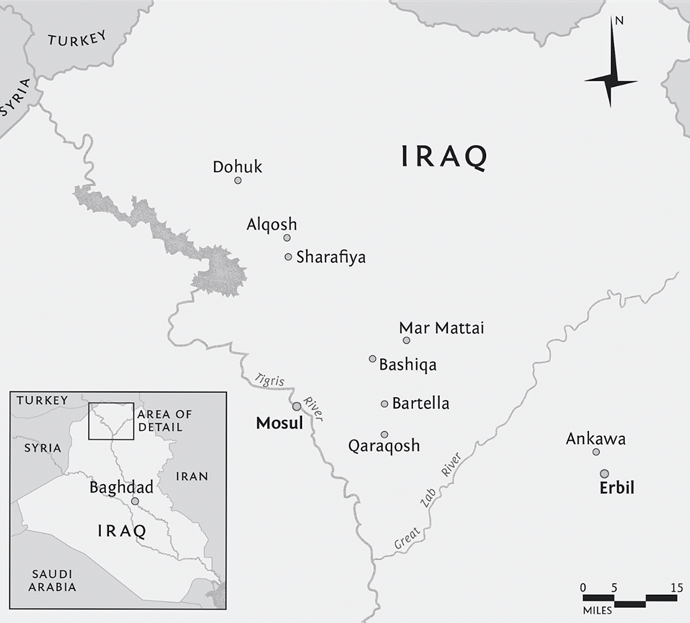
Map by Dolly Holmes
During Saddam Hussein’s regime, which lasted from 1979 to 2003, I began tracking Christians in Iraq. After working and living alongside them over many years, I had learned how Christians throughout the Middle East survived brutal dictatorships: often endorsing the regimes in return for protection, as they did in Iraq under Saddam, as they did in Maaloula, in Syria, where Christians would tell me quietly that they preferred Bashar al-Assad to theoretically worse alternatives.
Then came the American invasion of Iraq. The country’s unraveling. The Syrian civil war. The bloodshed in the West Bank and Gaza. The attacks on Christians in Egypt. Finally, the rise of the Islamic State, a group that’s certain to return in some new form even as President Donald Trump boasts of its defeat. Christians in the Middle East who have survived all this are likely to face peril once more.
The majority of Iraqi Christians are ethnic Assyrians, who belong to the Catholic Chaldean denomination. They have roots in the region that go back two thousand years, and some claim that they can connect their family trees with the apostle Thomas, who came to Mesopotamia to evangelize during the first century. The Garden of Eden is believed by some researchers to have been in Iraq—sometimes drivers would tell me it was near the mythical Hanging Gardens of Babylon, south of Baghdad. Abraham came from Ur, a Sumerian city-state, which scholars believe was located two hundred miles outside the capital. I drove through the country, north to south, taking notes on an ancient culture I knew could disappear.
The persecution of Christians in Iraq began as early as the thirteenth century. But in recent years it has reached a tipping point, setting off a mass exodus. In 2002, when I was living in Baghdad, six months before the US invasion, there were nearly 1.4 million Christians in Iraq. Today there are between 250,000 and 300,000 left, according to Samuel Tadros, a fellow at the Hudson Institute.
On most Sundays in Baghdad, I worshipped at the white stone St. Mary’s Chaldean Church. Sitting with people who were meditating and singing quietly in an ancient language was a respite from the madness of the country as the war approached. Everywhere I went, I was watched by Saddam’s secret police, the Mukhabarat. The maids in my hotel searched my drawers and emptied my pockets. Compromising films, often of a sexual nature, were made of journalists and visiting diplomats. On nights when Saddam’s crazed sons, Qusay and Uday, visited my hotel, I stayed locked in my room. Everyone whispered.
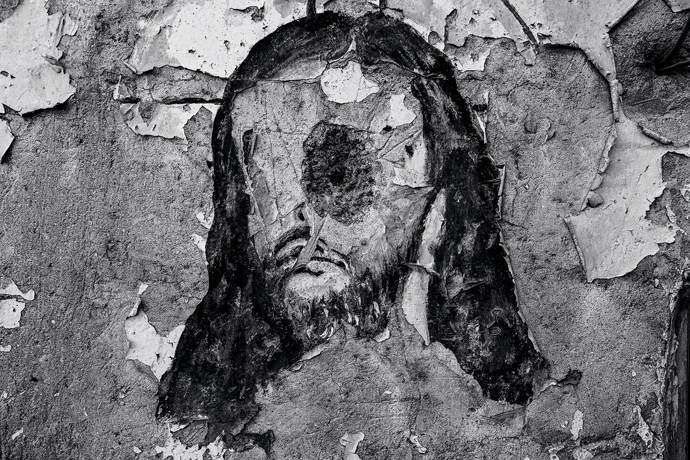
A defaced image of Jesus outside the Mar Shimoni Church, Bartella
After mass, my Palestinian driver and I used to have lunch at a Christian restaurant that served chicken sandwiches on toasted saj, dough placed on a hot griddle and baked over a wood fire, something like a Middle-Eastern pizza. I frequented a Christian grocery store that sold alcohol and other rare but pricey provisions. When I had the permission of Iraqi officials, I drove north to Mosul and Nineveh, to meet with the Christian communities, stay in people’s homes, celebrate holidays, and talk to the priests and bishops. “In five years we will be no more,” one priest told me, in 2003. At the time, it seemed alarmist, but his words contained a kernel of truth.
Saddam’s Iraq was ruled by the secular Ba’ath Party, which, as with secular regimes in Egypt, Algeria, and Turkey, had long protected Christians in exchange for their support. Saddam belonged to the Sunni branch of Islam, which represented fewer than 40 percent of Iraqis. Because his government was itself one of minority rule, other minorities including Christians enjoyed a degree of security. Many Christians told me that they felt better protected under that regime than they currently do.
It is hard to imagine benefiting from a regime as brutal as Saddam’s. Yet, “there was a kind of a social contract in Iraq,” between minorities and Saddam, Adeed Dawisha, a professor of political science at Miami University in Ohio told PBS NewsHour. “Under Saddam, it was understood that if you don’t interfere in politics, then you are provided with a good life. If the Christians supported Saddam, not because they loved what he was doing, it was in fear of the alternative.”
Christians prospered economically during that time. They were businessmen, doctors, lawyers, and engineers. They ran the shops, the markets, and the nicer hotels. A select few were part of the political elite, such as Tariq Aziz, who served as foreign minister and deputy prime minister under Saddam. But despite the secularism promoted by the regime, ancient rifts endured.
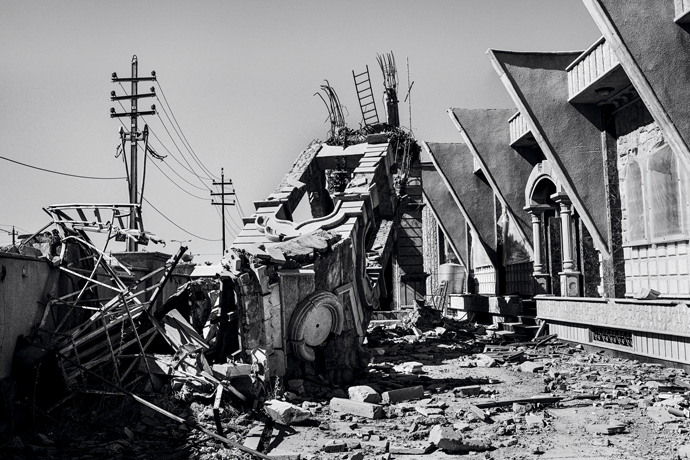
A bell tower, which was destroyed by the Islamic State, at the Mar Behnam and Sarah Church, in Qaraqosh
During Saddam’s last days, when it became clear that the Bush Administration was going to invade, anxiety replaced this uneasy tolerance. There were rumors that Saddam and his people had resolved to go down in flames before the Americans reached the center; that all Westerners would be rounded up and tried as traitors; that the Shia would take revenge on the Christians who had sided with Saddam.
In December 2002, reporting for the Times of London, I went to a special mass in Mosul in honor of St. Thérèse of Lisieux, the French Catholic saint who was known as “the Little Flower.” As I knelt, people rocked, prayed, and sobbed as if they were grieving the death of a family member. As St. Thérèse’s bones passed through the church, and the Aramaic chanting grew louder, the worshippers touched the wooden box that contained the saint’s remains, as if she might rise up and rescue them. One blue-eyed Assyrian woman next to me was convulsed in tears. “Please, don’t let this war happen,” a petite nun said, grabbing my hands. Four months later, US Marines tore down the statue of Saddam Hussein in Firdos Square.
After the invasion, attacks against Christians became more frequent, inspired by Osama bin Laden’s messages. A Sunni Jordanian named Abu Musab al-Zarqawi planted the early seeds of Al Qaeda in Iraq in 2004. His targets were Shiite Muslims—to extremist Sunnis, inauthentic Muslims—and Christians. At the same time, another jihadi group, Ansar al-Sunna, also began to threaten Christian families. Then came the Islamic State.
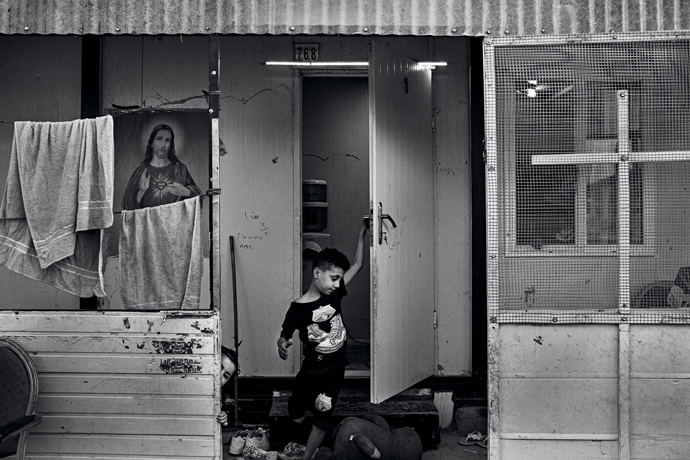
Children play outside their temporary home at the camp for internally displaced Christians, in Erbil.
These insurgency groups launched a series of bombings that targeted many churches in Iraq, including St. Mary’s, where I had worshipped before the war. In a horrific incident on October 31, 2010, a group of jihadis from the Islamic State wearing suicide vests entered Our Lady of Salvation Church in Baghdad during the evening mass, and killed fifty-eight people, including priests, worshippers, and police officers. The brutal attack was an act of retaliation against a Florida evangelical minister who had threatened to burn the Koran. In a later message, the Islamic State called the church a “dirty den of idolatry.”
On June 10, 2014, the Islamic State captured Mosul. I was in my hotel room listening to the BBC when my driver rushed in. He was hearing reports that the Islamic State was only sixty miles from the capital. For days, we had no news, and then the reports began to trickle out. Christians were told to leave or die. Soon after, I visited William Warda in his Baghdad home. Warda was the head of political and military affairs for a political party called the Assyrian Democratic Movement. He was born in Mosul and graduated from the university there. When I found him in his office, he was distraught. He was trying to reach his relatives, but the phone lines were down. “It’s a cleansing of all Christians from the region,” he said.
We sat drinking coffee in a dark room, and Warda shifted the cup between his hands. His aides came in and out, speaking urgently to him in Arabic. People were showing up at his door for advice: Should they stay in Iraq and risk extermination, they asked, or flee to join relatives outside the country and risk living in permanent exile? “How can I tell them not to go?” he asked, his voice thick with sorrow. “I know they have no future here. But if they go . . . we as Christians have no future here.”
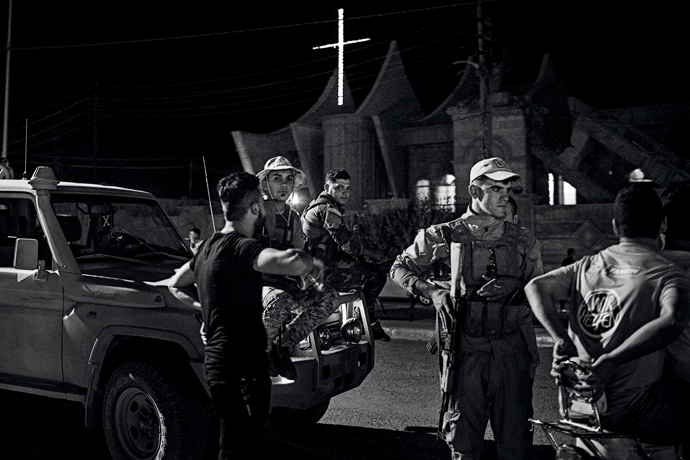
Soldiers of the Nineveh Plain Protection Units guard the main street in the evening, in Qaraqosh.
After the meal at Mar Mattai, the congregation retreated to the shade. In the quiet days after the Islamic State was pushed out, the group was racked with anxiety. Most insecure were the young, such as Sara Bahodij, a twenty-three-year-old from Mosul. Bahodij told me that her family was able to remain in the city for a few months after the occupation because they paid the jizyah. She said that there was a sliding scale depending on a family’s wealth.
“It could be ten thousand dollars, it could be a thousand dollars, it was whatever they wanted to charge,” Bahodij said bitterly. She told me that her father sold the family’s gold. Even then, the family did not feel safe. Christian women were used to wearing Western-style clothes—jeans, T-shirts, and, for the younger women, long flowing hair. But now they had to cover up with abayas. Islamic State fighters went from house to house, marking the doors of Christians with the letter n, an ancient reference to Nasrani, or followers of Jesus of Nazareth.
After the meal, I met Elham, a primary-school teacher who looked much older than her fifty-nine years. She remembered that before the invasion she “had many Muslim friends. But even if we felt protected, we felt odd. They still looked at us as if we were weird—because we were Christians, and they were Muslims. I always felt they were looking at me as if I was wearing strange clothes.”
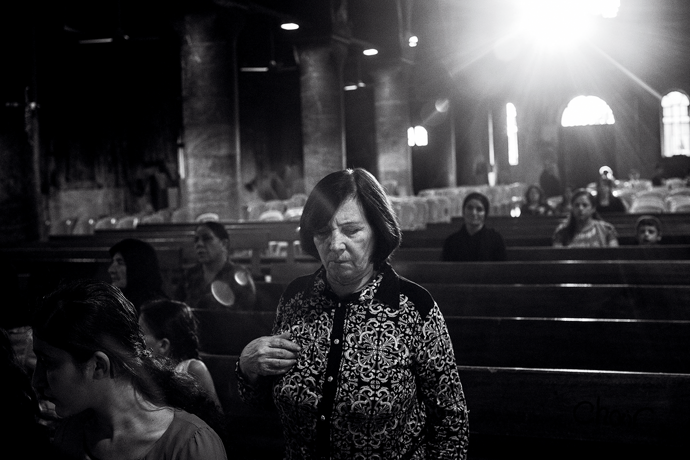
Mass at the Al-Tahera Church, in Qaraqosh
It was in 2008, Elham told me, that things began to unravel. Insurgency groups, the beginning of Al Qaeda in Iraq, told her family to leave their home in Mosul. “They knocked on the door and said we would be safer if we left,” she said. “They reminded me I had three sons.”
The family stayed until August 2014. This time, they could not disobey. Elham’s family packed up in an hour, and drove to Qaraqosh with a few Christian Orthodox families. Before the rise of the Islamic State, it was one of the most prosperous towns in the region, and Elham assumed it would survive.
Then, the surrounding Christian towns fell one by one. The Islamic State entered Qaraqosh from the north, and people fled east. On August 6, Elham packed up her family again, not sure where they could go. As they drove out of the town, Elham saw Islamic State fighters arriving in the distance. This is what the future looks like, she thought: men in short pants with beards. “We did not want to stay to welcome them,” she says, shuddering at the memory. The family spent several months staying with friends or relatives—anyone who would host them.
Nearby, I met a twenty-four-year-old named Nazar Esa. “The streets were packed with cars, with people on foot, with everyone running away,” he recalled. “It was four am—utterly surreal.” His family went to Dohuk, further to the north. Qaraqosh became an urban battlefield, with militants wearing suicide vests engaged in hand-to-hand combat against Iraqi Army soldiers in the streets.

A destroyed statue of St. George at the Mar Gorgis Church, in Qaraqosh
Meanwhile, the Islamic State’s rhetoric toward Christians grew more belligerent. In October 2014, the front page of one of the group’s magazines featured a picture of St. Peter’s Square in Rome with the group’s flag superimposed atop the obelisk facing the Papal Basilica—at the center of the heart of Christianity. In 2015, the group released a video titled “A Message Signed with Blood to the Nation of the Cross,” which showed the execution of Egyptian Christians. The leader of the Islamic State, Abu Bakr al-Baghdadi, had by then promised to march “all the way to Rome,” to “break the crosses” of the Christians along the way, and to “trade and sell their women.”
In October 2016, the Iraqi Army liberated Qaraqosh. Nazar went back to help clear explosive devices alongside the Nineveh Plain Protection Units (NPU), a military organization made up largely of Assyrian Christians that was formed in late 2014 to defend against the Islamic State.According to NPU Captain Sabri Rafo Ibrahim, a thousand homes were destroyed and another three thousand were partially burned. As Nazar walked through the destroyed town, he was in tears. But, he told himself, he was home. “It was like a boyfriend separated from his girlfriend, and then we found each other again,” he said. “We have an old saying here. This village is ours. We don’t give it to anyone.”
As we spoke, a few dozen people gathered in a circle and began to play a dancing game. These were extended families, bound together by fear, dread, and a sense of survival. At the height of the Islamic State’s expansion, sixty-five families lived in the Mar Mattai monastery, taking shelter in rooms packed with ten or more people each. Now those rooms are used for families to chat after lunch. The conversation I overheard in each was the same: how would they rebuild their shattered churches and charred homes, pockmarked with shells and bullet holes; how would they support their families.
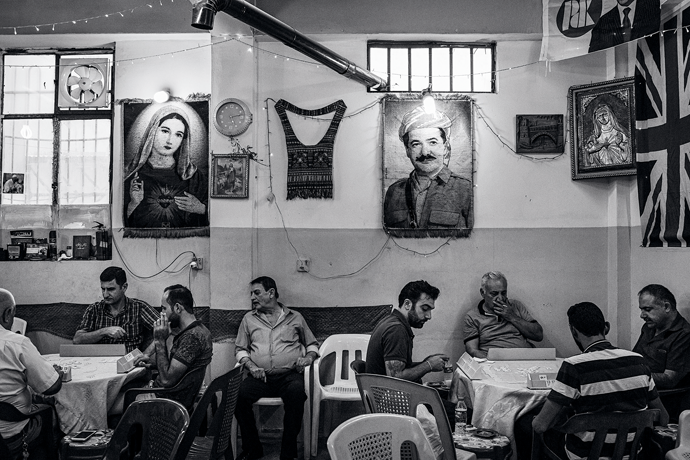
Men play a board game at a tea house in the Ankawa Christian neighborhood, in Erbil.
“ISIS was as close as Bashiqa,” said Father Joseph Ibrahim, one of the Assyrian priests, pointing down the hill to the town just beyond the walls of the monastery. “If they wanted to occupy the monastery, they could have easily done it.”
Brought up in Mosul, he is less afraid of the Islamic State than he is of the unknown. Father Ibrahim’s brother, an outspoken Christian leader, was killed in 2006 by Islamic jihadis during the first wave of Christian killings. “The killers were not ISIS but they had the same mentality,” he says. “ISIS might be gone, but the sentiment is not.”
Ayoung mother came shyly to Father Ibrahim, holding a five-month-old baby, who was born at the end of the Islamic State’s occupation. The woman, called Rita Emad Abdulahad al Nisser, was twenty-four, and wore long hair and a T-shirt that read: live in paris. love in paris. She offered the infant to the priest, who blessed the baby. Rita was Elham’s daughter-in-law. Her parents worked at a pharmacy in Bartella, a town of fifteen thousand, a dozen miles east of Mosul. In 2014, Rita was in her last year of university studying English literature with “three exams to go” when the Islamic State arrived. As she spoke, her memories of the night the Islamic State fighters arrived grew closer—a phone call at six in the morning from a relative in a nearby village; her father in tears, waking her and her siblings; his grim instructions to pack a small bag. Her hands shook as she spoke.
“ISIS were everywhere—so quickly,” she told me. She and her family loaded their SUV and headed to Erbil, where they joined a community of some thirty thousand Christians.
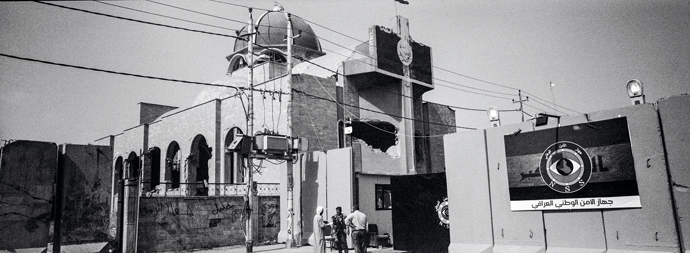
The destroyed Mar Ephrem Chaldean Church with the remnants of an Islamic State flag painted on its front, in Mosul
“We thought we would only stay in Erbil a few hours,” Rita said. “That it would all be over in days.” But this purge was more brutal. The Islamic State obliterated houses and universities, burning books and gardens. They stole first, then bombed or burned, Rita said. The university she had attended was destroyed. In June 2017, the family returned to their home to find broken furniture, smashed dishes, and torn curtains.
Sara, the twenty-three-year-old, who is Rita’s cousin, walked over to join us. “We just get promises. Promises for new homes, promises for jobs. Promises that ISIS will be gone forever. Promises that we will live in peace,” she said. The alternative is to emigrate to the United States. “In a few years,” she added, “everyone will be gone.”
Whether emigration is the real threat to Christians in the Middle East remains to be seen. Although Donald Trump’s election caused a dramatic dialing back of human-rights diplomacy, the presence of his vice president, Mike Pence, a conservative evangelical, meant there was still a chance of an effort to protect persecuted Christians. In September 2017, Trump had signed his third version of the travel ban, which implied that Christians would still be welcomed to the United States. I remember feeling an ominous sense of confusion. I was relieved that my Christian friends in the Middle East could find refuge in America, but I was deeply concerned about the greater connotations of their embrace by far-right evangelicals. I did not want them to be used as “good refugees” as opposed to “bad refugees”—i.e., Muslims.
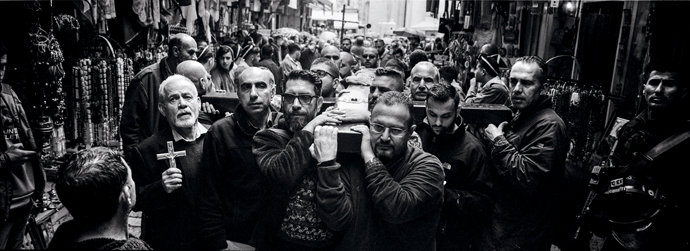
Palestinian Christians carry a wooden cross through the Old City of Jerusalem during a Good Friday procession.
That October, Pence spoke at a dinner for In Defense of Christians, an advocacy group, where he declared, “Christianity now faces an exodus in the Middle East unrivaled since the days of Moses.” He pledged that the United States would “work hand in hand, from this day forward, with faith-based groups and private organizations to help those who are persecuted for their faith.” Pence even floated the idea of a Middle-East visit to highlight the plight of Christians in the region.
Then in December, Trump announced that he would recognize Jerusalem as Israel’s capital and move the US Embassy there. As a result, many Christian leaders in the region who are generally pro-Palestine—including the Coptic Pope—refused to meet with Pence during his visit in January 2018. During the trip, Pence addressed the Israeli Knesset, where he announced an accelerated timeline for the embassy move, sparking protests by Arab lawmakers, and spoke of spending $110 million to assist Christians and other religious minorities in the Middle East.
The Christian share of refugees admitted to the United States had risen to 63 percent by last spring, up from 47 percent the year before—mostly because the total number of refugees admitted to the United States has plummeted. And the overall number is likely to decline even more. Among other reasons, the administration’s border policy has meant that many refugees are turned away before being allowed to apply for asylum.
It’s hard to imagine any foreign policy strategy that could do much to change the widespread crisis facing Christians in the Middle East. For the past two millennia, they have lived through periods of quiet tolerance interrupted by bursts of brutal persecution. The fall of the Ottoman Empire and First World War contributed to the first such wave in modern history; the American invasion of Iraq in 2003 to the second. The chaos sown in the aftermath of that latter conflict has compromised the safety of countless Christian communities beyond Iraq, including those in Egypt, Syria, and perhaps even Lebanon. In each of those places, conflict has made the already complicated and dangerous position of Christians even more precarious.
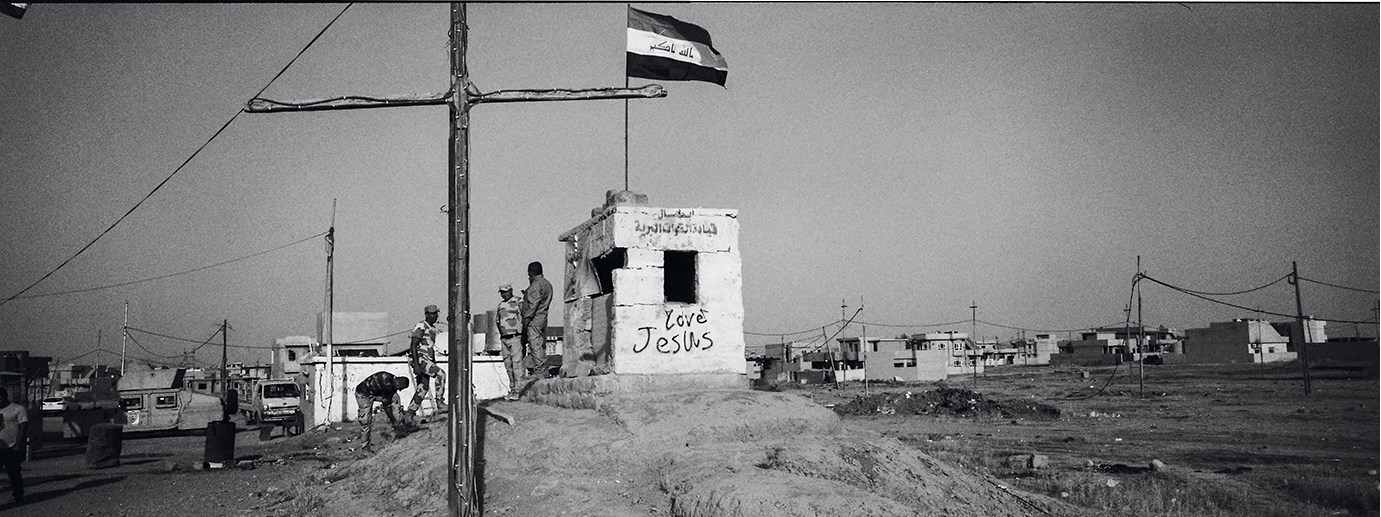
Graffiti on a checkpoint operated by the Nineveh Plain Protection Units and the Iraqi Army at one entrance to Qaraqosh
Egypt has the largest population of Christians in the Middle East, and it was a majority-Christian nation from the second century until the tenth century. The most reliable estimates suggest that between 6 and 10 million Coptic Christians live there today. Hostility toward Christians has erupted periodically into deadly sectarian mob attacks, including more than a dozen during Hosni Mubarak’s tenure, from 1981 to 2011. There is a long-standing pattern of government negligence or even complicity in the face of these attacks, and victims have typically been denied justice through the courts.
In the years since the Arab Spring, attacks on Coptic Christians have become more frequent, often triggered by perceptions that the community has aligned itself with anti-government forces. The head of the largest Coptic denomination told Amnesty International that more than forty churches were damaged or destroyed around the country in August 2013. The military refused to protect the churches and attackers were not held accountable.
The Islamic State has brought a new threat to Egyptian Christians, with loyalists carrying out murders and suicide bombings in the Sinai Peninsula and around the country. The NGO Open Doors counted a total of 128 Christians killed in the country in 2017 because of their faith and described their position there as one of “unprecedented persecution.”
The rise of the Islamic State and other Islamist groups has also driven an exodus of Christians from Syria. St. Paul led his first mission to the city of Antioch, which was part of ancient Syria, now in Turkey. This is where Jesus’ disciples were called Christians for the first time. In 2011, during the early days of the Syrian civil war, I spent time with the nuns at the Shrine of St. Takla in the city of Maaloula as they gathered baskets of apricots for jam, and women from all over the country came to pray for fertility. I met Christian shopkeepers, restaurant owners, taxi drivers, and families who spoke to me about the harmony of the city. I tried to keep in touch with people I knew there, but as time went by, it was more and more difficult to find them.
In February 2015, Islamic State fighters attacked several Christian towns in northeastern Syria and took hundreds of people hostage. Three were executed, and the rest were eventually ransomed. As a result of the Syrian civil war, 5.6 million people have fled the fighting. According to reporting in the Independent, virtually all Christians in the northeast of the country have left, taking with them a rich cultural tradition that dates to the earliest days of the faith.
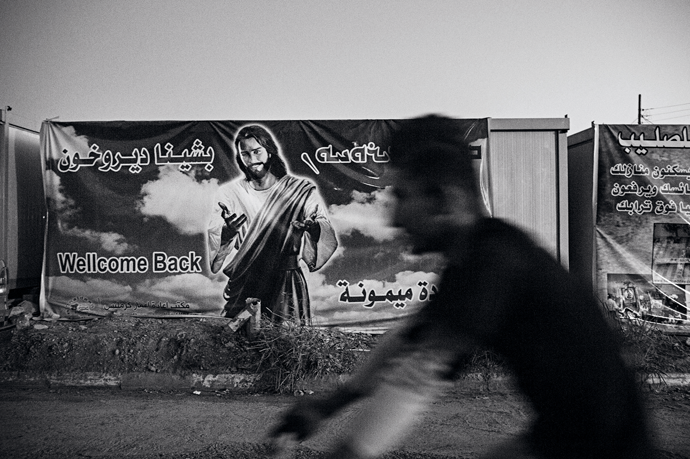
banner welcoming Christians home, in Karamless
And the conflict has had ripple effects reaching even Lebanon’s Christian community. With as many as 1.5 million Syrian refugees there, the overwhelming majority of whom are Sunni Muslims, the demographic balance of Christians and Muslims in the country—the basis for a long-standing power-sharing agreement—has begun to tilt, creating a sense of unease.
Christians are being pushed from the region by other factors as well. In the Gaza Strip, the cultural loss feels particularly acute, given that Palestinian Christian communities date back to the original followers of Christ. In 2007, the last extant Christian bookstore was firebombed, and the owner, Rami Ayyad, a Baptist, was murdered by extremists. He had received death threats from jihadis for months, but had refused to close his shop. And besides such flash points, a stifled economy and shattered infrastructure—results of the brutal Israeli occupation—have driven out those in Gaza who are able to emigrate; Christians, who have a somewhat easier time getting permits to cross into Israel, find ways to settle elsewhere. Today only about a thousand Christians remain, from a community that numbered roughly 4,500 just six years ago. Some predict that in ten or so years, none will be left.
Taken together, the diminishment of these communities amounts to a massive upheaval for an ancient faith, beyond the burden of any one country.
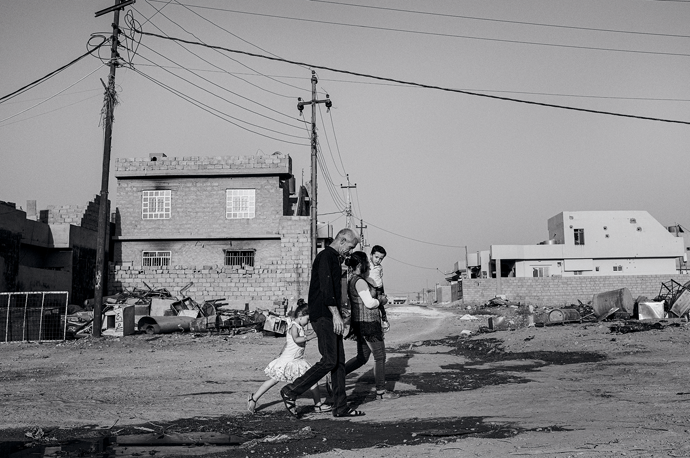
A family in Qaraqosh
As the Islamic State advanced, some of the Christians from Nineveh fled to villages that were outside the group’s control; others ended up in teeming refugee camps outside Erbil; some went further north to Dohuk. Some slept on the ground below the chipped statue of the Virgin Mary in Ankawa, a Christian suburb of Erbil, for weeks before finding temporary homes.
In Erbil in 2015, I met Aziz Emmanuel al-Zabari, a Chaldean Catholic professor from Salahaddin University. Al-Zabari had fled Mosul in 2006, when he felt that rising tensions were making it unsafe for Christians. He told me how to find the houses where Christians were camped out with relatives in Ankawa and in refugee camps on the roads leading out of the city. Wandering through the camps, I stopped to talk to families. I sat inside dark tents with old women who were baffled as to why they were there. “Are they trying to kill us all?” one woman asked me. “Are we ever going to be able to go home?”
That October, I traveled to Qaraqosh, where most streets were now piles of rubble, and teenagers associated with the Nineveh Plain Protection Units were taking selfies at makeshift checkpoints. On the main drag, a few kebab shops were open, as well as a barbershop. We bought some chicken and ate outside, watching men drink tea and some Shia women, dressed in abayas, with their children. On Saturday night, at holy mass, the bombed-out church had a large crowd of people. Afterward, the ice-cream shops, recently opened, were full of teenagers and families wheeling babies.
I also made a visit to the Monastery of the Virgin Mary, near the village of Alqosh, some fifty miles north of Mar Mattai. There, I met Father Andrew Toma, who told me that over the centuries, Christians had adapted to being outsiders. “An eagle will live here, with all these pigeons,” he said. The real fear, he said, is the uncertainty, the lack of an economic future.
“In the 1980s, Christian families left because they did not want their sons to fight in the Iran–Iraq War,” Father Toma explained. “Now they are leaving because there is no life for them. How can I tell them to stay? How can I save them?” The priest sat down wearily on an ancient wall in his home. “I can’t even save myself.”
Down the road, Sharafiya was a ghost town, an abandoned village destroyed by the Islamic State until, slowly, families began returning. Father Asad, the local priest, told me it was a community with four hundred families, most of whom had fled. “People left their animals and their houses, took their gold, and left quickly,” he said. He remembers the rows of cars stuffed with people and possessions.

A statue of the Virgin Mary outside the Monastery of the Virgin Mary, in Alqosh
But people were determined to restart their lives, and last January, thirteen babies were baptized in Sharafiya’s restored Church of St. George. Six months before, when I attended an evening mass, there were only a handful of worshippers in the pews. Still, Father Asad told me, politics would continue to haunt the Christians here: “It’s not about me convincing people to stay,” he said. “We have no problem with Kurds and Arabs. But if the Kurds and Arabs continue to fight, we will be the victims in this game.”
Passing through strings of tiny villages that had been deserted after the departure of the Islamic State was eerie. In Sharafiya, there was virtually no sound except for the bleating of goats. From far away, I heard a distant horn blowing. Fields were overgrown. Houses were empty, and doors opened as though people had left for just a moment, expecting to quickly return.
On my last day in Nineveh, I climbed a hill to Rabban Hormizd Chaldean Monastery as the sun was setting. I could have been taking those steps in the seventh century. The monastery was empty, lit by a few flickering candles, and in the far back, in a tiny chapel, I found a beautiful evening prayer vigil with chants and songs in Aramaic led by an Iraqi-Australian priest called Father Isaac Royel. With his wife, he had come to visit his elderly mother in the nearby village of Alqosh.
Father Royel had been a monk since he was twenty. “I wanted to live a spiritual life—I was dying in the real world,” he said. “I wanted a connection to spirituality that I could only get through fasting, vigils, and prayers.”
But the Christian faith is diminishing in every way, he said, even in this ancient place. “This is our roots. For people moving from the East to the West, it is very difficult, because they will assimilate, and we will disappear forever. The West is technology, knowledge. The East is something more traditional. If something is demolished, it can never again be rebuilt.”



